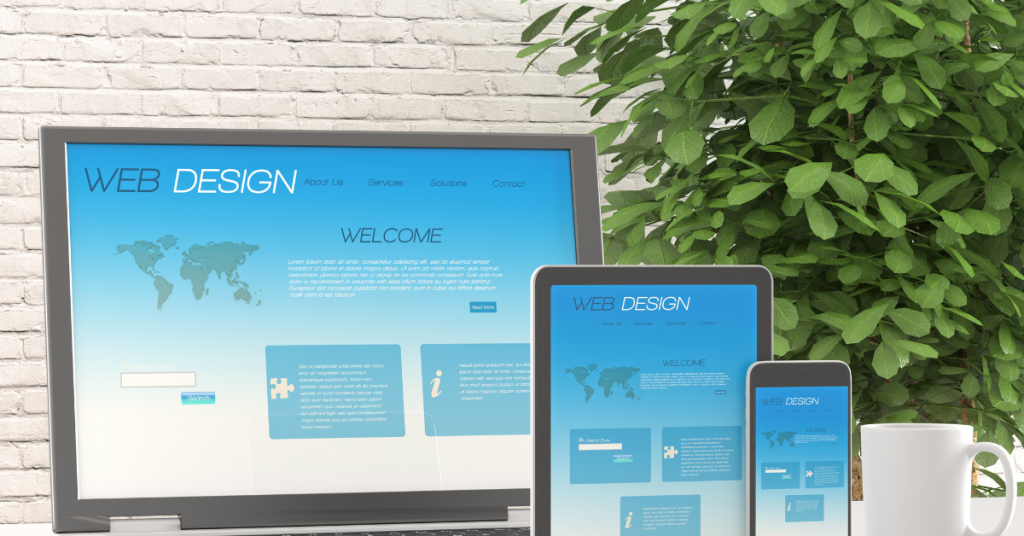In the fast-paced digital landscape, website design trend evolve rapidly. Staying updated with these trends is crucial for businesses to maintain relevance and meet the expectations of their audience. In this article, we’ll explore key website design trend that have proven their staying power. From responsive design to minimalist layouts and innovative techniques like dark mode and microinteractions, we’ll delve into strategies for creating modern and user-friendly websites. Join us as we uncover the essential elements of contemporary website design that are here to stay.
Responsive Design and Mobile Optimization

In today’s interconnected world, where users access websites across a multitude of devices, responsive design and mobile optimization have become imperative. Here’s a closer look at why these elements are essential for contemporary website design:
Importance of Responsive Design:
Responsive design ensures that websites adapt seamlessly to various screen sizes, resolutions, and orientations. With the proliferation of smartphones, tablets, and laptops, users expect websites to be accessible and visually appealing across all devices. A responsive design approach allows for fluidity in layout and content presentation, enhancing user experience and engagement.
Strategies for Effective Mobile Optimization:
Mobile optimization goes beyond merely resizing elements for smaller screens. It involves optimizing images, streamlining navigation, and prioritizing content for mobile users. Implementing techniques like touch-friendly buttons, simplified forms, and accelerated mobile pages (AMP) can significantly enhance the usability of a website on mobile devices.
Impact of Mobile-First Indexing:
With Google’s shift towards mobile-first indexing, where the mobile version of a website is prioritized for search engine rankings, mobile optimization has become even more critical. Websites that are not mobile-friendly risk losing visibility and traffic in search results. Therefore, prioritizing mobile optimization ensures that websites remain competitive in the digital landscape.
Minimalist and Clean Layouts
In an era inundated with information overload, minimalist and clean layouts have emerged as a beacon of clarity and sophistication in website design. Let’s delve into why these design principles are not just trends but enduring elements of effective web design:
Embracing Simplicity:
Minimalist layouts prioritize simplicity and clarity by removing unnecessary elements and focusing on essential content. By employing ample whitespace, concise typography, and streamlined navigation, minimalist designs create a visually pleasing and distraction-free user experience. Users are more likely to engage with websites that offer intuitive navigation and clear communication of information.
Benefits of Minimalist Layouts:
Minimalist layouts offer numerous benefits for both users and businesses. They enhance readability and comprehension, allowing users to absorb information quickly without feeling overwhelmed. Moreover, minimalist designs load faster and perform better across devices, contributing to improved user satisfaction and lower bounce rates. From a business perspective, minimalist layouts can convey professionalism and sophistication, reinforcing brand identity and credibility.
Techniques for Achieving Clean Designs:
Achieving a clean and minimalist design requires careful consideration of layout, typography, color, and imagery. Designers must prioritize content hierarchy, ensuring that the most important information is prominently displayed while secondary content remains accessible but unobtrusive. Utilizing a restrained color palette, opting for sans-serif fonts, and judiciously incorporating white space are key techniques for achieving a clean and elegant aesthetic.
Bold Typography and Custom Fonts
In the realm of website design, typography serves as a powerful tool for communication and visual expression. Bold typography and custom fonts have become prominent features of modern web design, elevating the visual appeal and brand identity of websites. Let’s explore why these elements are crucial for creating impactful and memorable designs:
Utilizing Typography as a Design Element:
Typography plays a pivotal role in shaping the overall aesthetic and user experience of a website. Bold typography, characterized by strong, attention-grabbing fonts, can instantly capture users’ attention and convey a sense of personality and style. By strategically using typography to emphasize key messages, headings, and calls to action, designers can guide users’ attention and enhance engagement.
Impact of Bold Fonts on Visual Hierarchy:
Bold fonts are instrumental in establishing visual hierarchy within a website’s layout. By varying font weights, sizes, and styles, designers can create contrast and emphasis, making important elements stand out while maintaining readability and coherence. Bold headlines and titles can draw users into content, while lighter body text ensures ease of reading and comprehension.
Importance of Custom Fonts for Brand Identity:
Custom fonts offer businesses an opportunity to differentiate themselves and reinforce their brand identity in a crowded digital landscape. By using unique typefaces that align with brand values and aesthetics, companies can establish a distinct visual identity that resonates with their target audience. Custom fonts evoke emotions, convey brand personality, and foster brand recognition, enhancing brand loyalty and credibility.
Dark Mode and Color Schemes

In recent years, the adoption of dark mode and thoughtful color schemes has become increasingly prevalent in website design. These elements not only enhance visual appeal but also contribute to improved user experience and accessibility. Let’s explore the significance of dark mode and color schemes in contemporary web design:
Exploring the Rise of Dark Mode:
Dark mode, characterized by a dark background with light text and elements, has gained popularity due to its aesthetic appeal and potential benefits for user comfort and device battery life. Dark mode reduces eye strain, particularly in low-light environments, and provides a sleek and modern look to websites. As a result, many popular platforms and applications now offer dark mode as a customizable feature, reflecting its widespread acceptance among users.
Psychological Effects of Color Schemes:
Color plays a vital role in shaping users’ perceptions, emotions, and behavior. Thoughtfully chosen color schemes can evoke specific feelings and associations, influencing users’ mood and engagement with a website. For example, warm colors like red and orange may convey energy and urgency, while cool colors like blue and green can evoke a sense of calmness and trust. Understanding color psychology enables designers to create harmonious and impactful visual experiences that resonate with users on a subconscious level.
Strategies for Implementing Effective Color Schemes:
Creating effective color schemes requires careful consideration of factors such as brand identity, target audience, and desired emotional response. Designers can employ techniques like color theory, contrast, and color psychology to craft compelling and cohesive color palettes that reinforce brand messaging and support user interactions. Additionally, accessibility considerations, such as ensuring sufficient color contrast for readability, are crucial for accommodating users with visual impairments.
Microinteractions and Animations
Microinteractions and animations have become integral components of modern website design, enriching user interactions and enhancing overall user experience. Let’s delve into why these dynamic elements are crucial for creating engaging and immersive web experiences:
Enhancing User Engagement with Microinteractions:
Microinteractions are subtle, interactive elements that provide feedback and guidance to users as they navigate a website. Examples include button animations, hover effects, and form validations. These small but meaningful interactions contribute to a more intuitive and enjoyable user experience by providing immediate feedback and reinforcing user actions. Microinteractions also add a layer of delight and personality to a website, making interactions feel more responsive and engaging.
Importance of Subtle Animations for User Experience:
Animations, when used judiciously, can significantly enhance user experience by adding visual interest, guiding user attention, and conveying information effectively. From animated transitions between pages to scrolling effects and loading animations, well-executed animations can create a sense of fluidity and continuity, making interactions feel seamless and effortless. However, it’s essential to strike a balance between enhancing user experience and avoiding overwhelming users with excessive animations.
Guidelines for Incorporating Animations Without Compromising Performance:
While animations can elevate user experience, they should be implemented thoughtfully to avoid negatively impacting website performance. Designers should prioritize lightweight animations that load quickly and smoothly across devices and network conditions. Additionally, optimizing animations for performance by using CSS animations or hardware acceleration can help minimize rendering delays and ensure a seamless user experience.
Accessibility and Inclusive Design

In today’s digital age, accessibility and inclusive design have become fundamental principles of website design, ensuring that websites are usable and enjoyable for all users, regardless of their abilities or limitations. Let’s explore why accessibility is crucial and how inclusive design principles can be integrated into web design:
Ensuring Websites are Accessible to All Users:
Accessibility involves designing websites and digital content in a way that is perceivable, operable, understandable, and robust for users with diverse abilities. This includes considerations for users with visual impairments, hearing impairments, motor disabilities, cognitive impairments, and other disabilities. Implementing accessibility features such as alternative text for images, keyboard navigation, captions for multimedia content, and semantic HTML markup ensures that all users can access and interact with website content effectively.
Importance of Inclusive Design Principles:
Inclusive design goes beyond meeting minimum accessibility standards by proactively considering the needs of all users throughout the design process. By embracing diverse perspectives and designing with empathy, inclusive design aims to create products and experiences that are usable and enjoyable for everyone, regardless of their age, gender, ethnicity, language, or abilities. Inclusive design principles prioritize flexibility, adaptability, and user empowerment, recognizing that diversity is a strength rather than a limitation.
Techniques for Improving Accessibility Through Design Choices:
Designers can incorporate various techniques and best practices to improve accessibility and inclusivity in web design. This includes providing clear and consistent navigation, ensuring sufficient color contrast for readability, offering multiple ways to access content, and designing flexible layouts that accommodate different screen sizes and input methods. Conducting user testing with individuals with disabilities and soliciting feedback from diverse user groups can also help identify accessibility barriers and refine design solutions.
website design trend Conclusion
In conclusion, the landscape of website design is continuously evolving, driven by advancements in technology, changes in user behavior, and shifting design trend. However, amidst this constant flux, certain design principles and trends have emerged as enduring pillars of effective web design.
From responsive design and minimalist layouts to bold typography, dark mode, microinteractions, animations, accessibility, and inclusive design, these elements represent not just passing fads but fundamental aspects of modern web design.
By embracing these trend and principles, designers can create websites that not only captivate users’ attention but also deliver seamless, engaging, and inclusive experiences across devices and user demographics.
As we move forward, it is essential for designers to remain adaptable, innovative, and empathetic, continually seeking new ways to enhance user experience and meet the evolving needs of users in an ever-changing digital landscape.



